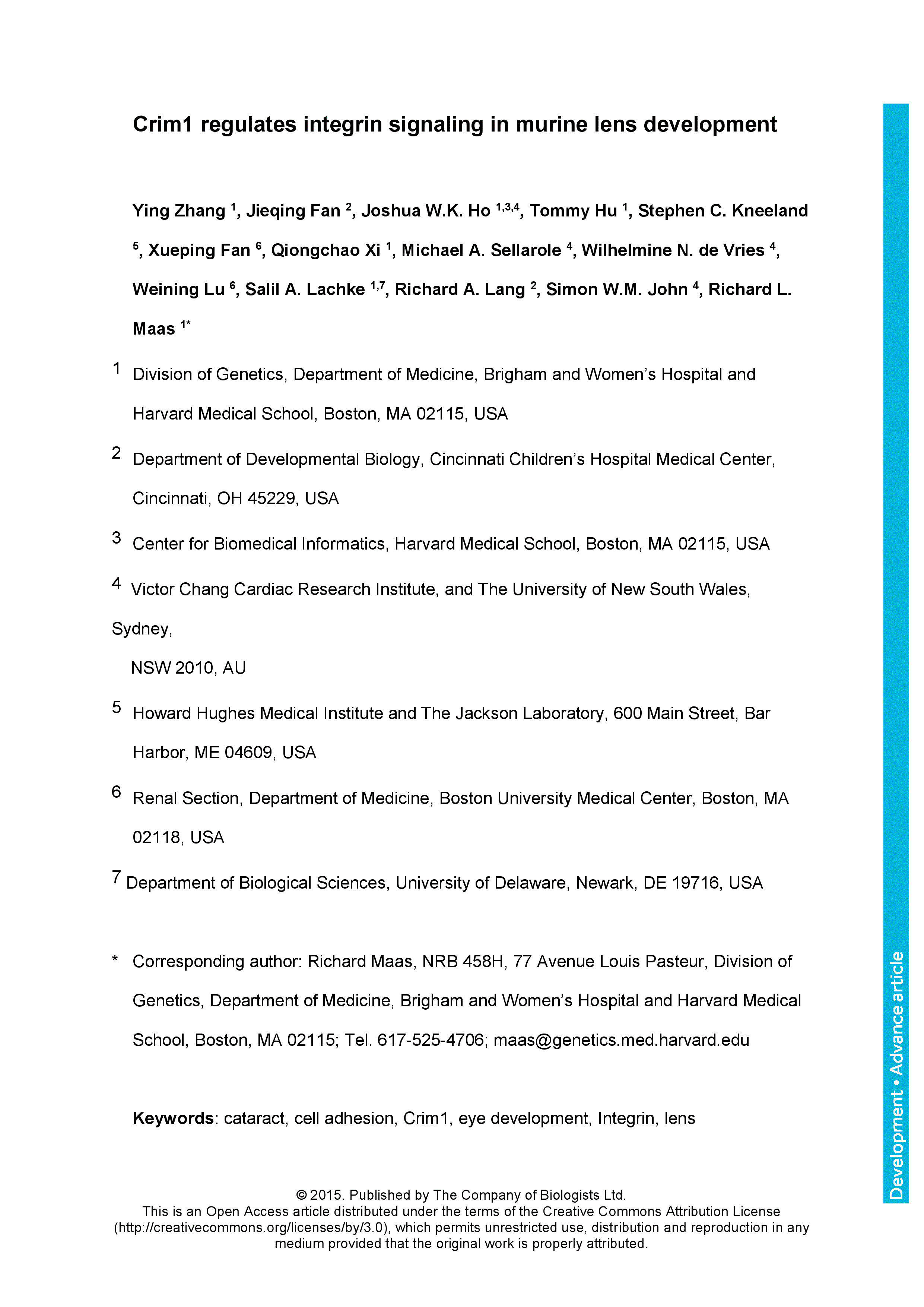The developing lens constitutes a powerful system for investigating the molecular basis of inductive tissue interactions and for studying cataract, the leading cause of blindness. The formation of tightly controlled cell-cell adhesions and cell-matrix junctions between lens epithelial (LE) cells, between lens fiber (LF) cells, and between these two cell populations enables the vertebrate lens to adopt its highly ordered structure and to acquire its optical transparency. Adhesion molecules are thought to maintain this ordered structure, but little is known about their identity or molecular interactions. Cysteine-rich motor neuron 1 (CRIM1), a type I transmembrane protein, is strongly expressed in the developing lens and its mutation causes ocular disease in both mice and humans. However, how Crim1 regulates lens morphogenesis is not understood. We identified a novel ENU-induced hypomorphic allele of Crim1, Crim1glcr11, which in the homozygous state causes cataract and microphthalmia. Using this allele and two other Crim1 mutant alleles, Crim1null and Crim1cko, we show that the lens defects in Crim1 mutants originate from defective LE cell polarity, proliferation and cell adhesion. The Crim1 adhesive function is likely required for interactions both between LE cells and between LE and LF cells. We further show that Crim1 acts in LE cells where it co-localizes with and regulates the levels of active β1 integrin and of phosphorylated FAK and ERK (pFAK, pERK). Lastly, the RGD and transmembrane motifs of Crim1 are required for the regulation of pFAK. These results identify an important function for Crim1 in the regulation of integrin- and FAK-mediated LE cell adhesion during lens development.
Crim1 regulates integrin signaling in murine lens development
Currently Viewing Accepted Manuscript - Newer Version Available
Ying Zhang, Jieqing Fan, Joshua W.K. Ho, Tommy Hu, Stephen C. Kneeland, Xueping Fan, Qiongchao Xi, Michael A. Sellarole, Wilhelmine N. de Vries, Weining Lu, Salil A. Lachke, Richard A. Lang, Simon W.M. John, Richard L. Maas; Crim1 regulates integrin signaling in murine lens development. Development 2015; dev.125591. doi: https://doi.org/10.1242/dev.125591
Download citation file:
Advertisement
Call for papers: Uncovering Developmental Diversity

Development invites you to submit your latest research to our upcoming special issue: Uncovering Developmental Diversity. This issue will be coordinated by our academic Editor Cassandra Extavour (Harvard University, USA) alongside two Guest Editors: Liam Dolan (Gregor Mendel Institute of Molecular Plant Biology, Austria) and Karen Sears (University of California Los Angeles, USA).
Choose Development in 2024

In this Editorial, Development Editor-in-Chief James Briscoe and Executive Editor Katherine Brown explain how you support your community by publishing in Development and how the journal champions serious science, community connections and progressive publishing.
Journal Meeting: From Stem Cells to Human Development

Register now for the 2024 Development Journal Meeting From Stem Cells to Human Development. Early-bird registration deadline: 3 May. Abstract submission deadline: 21 June.
Pluripotency of a founding field: rebranding developmental biology

This collaborative Perspective, the result of a workshop held in 2023, proposes a set of community actions to increase the visibility of the developmental biology field. The authors make recommendations for new funding streams, frameworks for collaborations and mechanisms by which members of the community can promote themselves and their research.
Read & Publish Open Access publishing: what authors say

We have had great feedback from authors who have benefitted from our Read & Publish agreement with their institution and have been able to publish Open Access with us without paying an APC. Read what they had to say.



